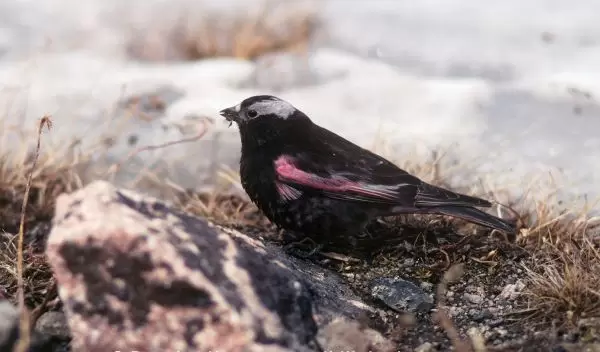
Tracking the Black Rosy-Finch: Hidden Treasure and Higher Learning in North America's Alpine Zone
Only three people known to recorded scientific literature had ever found a nest of the Black Rosy-Finch (Leucosticte atrata) before Maureen Ryan attempted the challenge in the summer of 2002. Using geographic information systems (GIS) technology and strong mountaineering skills, the University of Wyoming student became the fourth – when she discovered a nest at an elevation of nearly 12,000 feet in Utah's Uinta Mountains.
The difficulty of exploring the Black Rosy-Finch breeding habitat has severely limited scientific study of the birds and made finding one of the nests a rare event. In late spring, the alpine birds migrate to their mating grounds above the timberline. There, generally between elevations of 10,000 and 13,000 feet, the birds build their nests inside cliff crevices and on talus slopes (large boulders) -- predominantly in the remote reaches of the Rocky Mountains and on the edges of the Great Basin in the western United States.
For Ryan, eager to gain research experience, the steep terrain added to the birds' appeal. At the time, Ryan was pursuing her second bachelor's degree, this one in zoology. Drawn to the outdoors after earning a degree in English, she had worked for several years in wilderness schools as a field guide and climbing instructor.
At the University of Wyoming, Ryan met David B. McDonald, an associate professor in the Department of Zoology and Physiology, who sparked her interest in studying what she calls "extremely hardy, perky birds" and their breeding territory. McDonald encouraged her to apply for an NSF-Wyoming-EPSCoR undergraduate research fellowship. (EPSCoR, short for Experimental Program to Stimulate Competitive Research, is a partnership between NSF and 24 states, including Wyoming, and 2 territories that promotes the development of science, engineering, technology and related human resources in those regions.)
"My EPSCoR grant was the first research proposal I ever wrote," says Ryan. "I always had the passion for learning science, but Dr. McDonald gave me the tools to know how to do science." McDonald directed Ryan's project with research funding he received from the National Geographic Society.
Ryan hiked into the Uinta Mountains, the first of her four field sites, to mark transects (grid squares) for sampling and observation with a hand-held GIS instrument. "By luck," she says, in the Reid's Peak area near the 11,700-foot summit, Ryan flushed a male Black Rosy-Finch from a crevice to a boulder four feet in front of her. A few seconds later, a female bird flew out from the same crevice. Reaching inside the crack, Ryan felt the nest with its clutch of five eggs.
McDonald urged Ryan to follow the new direction offered by her discovery of the nest. "Once we realized we could get at some of the parentage data – that was clearly the priority," she says.
Initially, Ryan's project focused on field-testing a preliminary GIS model for Black Rosy-Finch breeding habitat, developed by Nate Nibbelink of the Wyoming Geographic Information System Center and UW's McDonald. Ryan used the model's three topographic parameters -- elevations above 10,000 feet, steep cliffs, and permanent snowfields -- to select her sampling areas across Wyoming, Utah, and Colorado.
Subsequent discoveries of more nests proved how well the model worked to help predict the birds' breeding sites. McDonald found a nest in the Uintas, and Ryan found another on the Beartooth Plateau in Wyoming.
Ryan monitored all three nests and the progress of their 13 hatchlings. With McDonald, she banded and took blood samples from the nestlings and a male parent finch. "Those samples gave us the first-ever data on genetic parentage in this little-studied genus," she reports.
Using microsatellite DNA genotyping, a molecular technique for determining paternity in birds and other animals, Ryan and her UW colleagues discovered intriguing details about the Black Rosy-Finch's mating system.
While researchers had assumed that Black Rosy-Finch females were socially monogamous (pairing and raising a brood with one male partner), no one knew if the females were "genetically (sexually) monogamous."
According to McDonald, "About 25 percent of the young in each of the three nests found was not sired by the 'behavioral dad' (the male that attends the nest and helps feed the young)." Further tests revealed that these "extra-pair offspring" were the result of the females having "affairs" away from their nesting "neighborhoods."
Behavioral and population studies of the Black Rosy-Finch (and its two North American "cousins" – the Gray-Crowned and Brown-Capped rosy-finch species) are important to scientists and conservationists tracking the health and biodiversity of alpine ecosystems.
Researchers are especially concerned with the potential impact of large-scale climate change (warming temperatures, receding glaciers, and the loss of permanent snowfields) on high-altitude plants and animals. "If global warming continues, a significant portion of the breeding territory of North American rosy-finches could become unviable, which could lead to a loss of all but the most northern birds," Ryan says.
-- Moira Burns
